Legacy of Calico Early Man Archaeological Project
Fred E. Budinger, Jr.
Budinger & Associates
San Bernardino, California
SCA Proceedings, Volume 37 (2024) Budinger, 110-126
Abstract
This paper summarizes the legacy of the Calico Early Man Archaeological Project. The tools and flakes recovered from the Calico Site (CA-SBR-2102) are >200ka and those at the nearby Bassett Point Site are more than >198ka. Surface artifacts at the Calico Site and the surrounding hills are identified as the Lake Manix Lithic Industry and date >25ka. Artifacts found at the Rock Wren Locality at Calico date to 14.4±2.2ka. Calico Project personnel have surveyed and excavated at these locations during the last 60 years. The archaeological record in Manix Basin is the longest yet recorded in the United States.
Introduction
The longest archaeological record yet documented in the United States is in the Lower Mojave River Valley in the Central Mojave Desert of Southern California. This hydrologic basin held Pleistocene Lake Manix from about 25ka to 400-500ka. Lithic tools, cores, and flakes of the Lake Manix Lithic Industry (LMLI) are found in the northwest part of the basin above elevations of 543 m (1780 ft), the shoreline of the last stand of Lake Manix.
The Calico Site is a simple quarry and lithic workshop that has yielded a variety of both light-duty and heavy-duty tools and more than 60,000 technical flakes and pieces of angular debitage (flintknapping debris). The light-duty tools include a variety of scrapers (concave, notched, convex, straight-edged, end, convex side and end, strangulated, concave side and end, and thumbnail), denticulates (saw-like tools), gravers, burins (chisel-like tools), reamers, piercing tools, blades, and bladelets. Heavy-duty tools include choppers, chopping tools, hand axes, Calico Cutters (combination chopping and cutting tools), formed and unformed anvils, hammerstones, and pecking stones (Shlemon and Budinger, 1990; Budinger, 2004) No homonin fossils have been found. The Calico Site is listed on the National Register of Historic Places. Louis S.B. Leakey directed the Calico project from its start in 1964 until his death in 1972. The Calico Project has two foci of investigation and debate: (1) the authenticity of the specimens as bona fide artifacts (the “artifact/geofact” issue); and (2) the age of the host alluvial fan deposits.
The Calico Site is dated to >200ka; the nearby Bassett Point Site is >185ka. The Rock Wren biface, at the Calico Site, is dated to 14.4±2.2ka. Tools of the Lake Manix Lithic Industry are judged to date >25ka.
The Manix Basin
During the middle and late Pleistocene, the Mojave River, an allogenic stream with its source in the San Bernardino Mountains, transported water north and east to the Manix Basin, located east of the modern city of Barstow, California. The basin is circumscribed by the Calico, Paradise, Alvord, Cady, and Newberry Mountains. These are composed of Precambrian rocks, Paleozoic and Mesozoic igneous and metamorphic basement rocks, and Cenozoic non-marine sedimentary rocks and shallow intrusive rocks. Figure 1 is a map of the Manix Basin.

Some 400-500ka, factors relating to the elevation of landforms, drainage patterns, annual precipitation, mountain snowpacks, cloud cover patterns, and evaporation were such that the Mojave River created Pleistocene Lake Manix. The lake persisted through much of Pleistocene times and drained approximately 25ka. The last stand of the lake had its shoreline at 543 m above mean sea level. It has a surface area of approximately 236 km² and a volume of approximately 3.15 km3. Lake Manix drained, catastrophically, approximately 25ka. A sedimentary section, known as the Manix Formation, contains rancholabrean fauna ranging in age from approximately 20ka->350ka (Jefferson 1968, 1985a, 1985b, 1987, 1989, 1991). The richest fossiliferous section has been dated by radiocarbon dating, uranium-series techniques, and trace element correlation of a tephra to a source well dated by potassium-argon techniques. Among the fossils recovered are camel, horse, mammoth, saber-tooth cat, dire wolf, short-faced bear, coyote, flamingo, pelican, eagle, swan, geese, mallard duck, ruddy duck, canvas-back duck, double-crested cormorant, greeb, crane, seagull, and stork. A detailed geomorphic history of the Manix Basin is available (Reheis et al. 2011).
Lake Manix Lithic Industry
Surface sites of the Lake Manix Lithic Industry have been recorded (Simpson 1960, 1976; Alsoszatai-Patheo 1975, Binning et al. 1985). These are devoid of pottery, shell objects, and projectile points. Artifacts, primarily of chalcedony, chert, and jasper, include oval bifaces, scrapers (end, straight, concave, pointed, convex, and plano-convex), cutting tools, choppers, stout picks, rotational tools, gravers, cores, anvils, and hammerstones. These artifacts are usually covered with rock varnish and often embedded in desert pavements. Younger Paleoindian artifacts at lower elevations are not varnished and not embedded in desert pavements. Based on its occurrence above the 543 m shoreline of Pleistocene Lake Manix, the assemblage is judged to be >25ka.
The East Rim Site (CA-SBR-2129) is a lithic workshop with artifacts on and beneath the surface to a depth of 15 cm (Alsoszatai-Patheo 1975). Pinyon and juniper pollen indicate that tools and flakes were deposited 14-17ka. Artifacts include choppers, scrapers (inside and convex), bifaces (ovate, wedge-shaped, and generalized), cutting tools, utilize flakes, hammer stones, pecking tools, and pointed tools. Figure 2 shows representative specimens of the Lake Manix Lithic Industry.
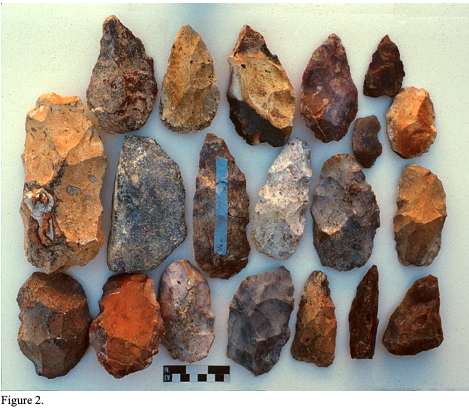
The Calico Site
The Calico Site (CA-SBR-2102; SBCM 1500A) is a lithic quarry and workshop site (Schuiling 1972, 1979; Simpson 1978, 1980, 1982, 1986; Budinger 1983; Budinger and Simpson 1985; Shlemon and Budinger 1990). The site has yielded a variety of both light-duty and heavy-duty tools and more than 60,000 technical flakes and pieces of angular debitage. The light-duty tools include a variety of scrapers (concave, notched, convex, straight-edged, end, convex side and end, strangulated, concave side and end, and thumbnail), denticulates (saw-like tools), gravers, burins (chisel-like tools), reamers, piercing tools, blades, and bladelets. Heavy-duty tools include choppers, chopping tools, hand axes, Calico Cutters (combination chopping and cutting tools), formed and unformed anvils, hammerstones, and pecking stones (Shlemon and Budinger, 1990; Budinger, 2004, Oberlander and Budinger, 2013). No homonin fossils have been found. The Calico Site is listed on the National Register of Historic Places. Louis S.B. Leakey directed the Calico project from its start in 1964 until his death in 1972. The Calico Project has two foci of investigation and debate: (1) the authenticity of the specimens as bona fide artifacts (the “artifact/geofact” issue); and (2) the age of the host alluvial fan deposits.
The Calico Site It is situated in alluvial deposits dated by sediment thermoluminescence (TL) to 135ka (Debenham 1998, 1999) and >200ka by uranium thorium dating (Bischoff et al. 1981) and about 198ka by cosmogenic beryllium-10 dating (Owen et al. 2011).
Tools were made from cores, flakes, and blades by hard and soft hammer percussion and bipolar reduction using anvils. Lithologies used include chalcedony, chert, and jasper. Scrapers, used for working wood, hide, bone, and antler, were fashioned on flakes and blades and are characterized by unifacial face and edge retouch. A small percentage of the artifacts recovered show use-wear patterns.
Ten scraper subtypes have been identified and are listed here with their incidence from the site’s Master Pits I and II, a combined excavated volume of 354.6 m3: concave (630), notched (557), convex side (347), straight-edged side (182), and (135), convex side and (33), strangulated (15), concave side and end (7), and thumb-nail (7).
Cutting tools have bifacially modified edges that are typically acute and equal. Three subtypes have been identified: denticulates, small saw-like tools (116); gravers, with retouched spurs used for incising (620); and burins, small cutting tools with transverse chisel-like edges (591). Burin subtypes in the Calico assemblage include burins on truncation, burins on breaks, dihedral burins, and becs (small tools with curved or beak-like spurs). Figure 3 shows representative specimens of the Calico Lithic Industry.
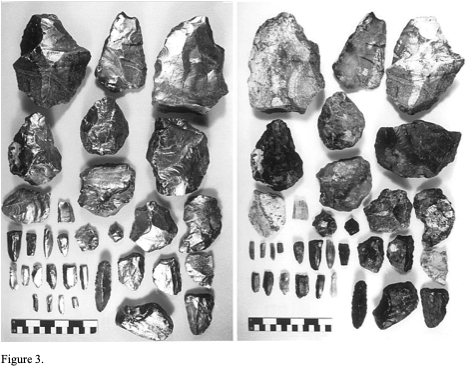
Most rotational tools are reamers. Use-wear indicates minute scaling indicative of clockwise or counterclockwise usage. Piercing tools have slender splinter-like spurs without retouch. Use-wear includes crushed tips and minute step-fractures. Modified edges that support piercing spurs often evince retouch and use-aware indicative of uses scrapers, cutting tools, or burins. Some 710 blades, 683 bladelets, and 182 bladelet cores have been recovered from Master Pits I and II. Blades are longer than 4.5 cm and bladelets are shorter. Figures 4-9 depict a variety of flakes, blades, scrapers, reamers, and a graver.
Heavy-duty tools were made from cores and core-like large flakes. Most cores are simple unprepared blocks from which flakes had been struck. Some show striking platform preparation. Bipolar cores are present; spectacular polyhedral cores are not.
Both large (>50 cm) and small formed and unformed anvils were used. With large anvils, a piece to be flaked was brought down forcefully on an anvil crest; with lap anvils the object was held on the end surface and then struck. Ground anvils of chalcedony or jasper are unmodified high-crested blocks or bifacially modified. The crests exhibit localized crushing, battering, and incipient cones of percussion.
Hammerstones are sub-rounded to oval, modified or naturally faceted class of chalcedony, church, and the site, or dayside; are typically about 10 cm in diameter and exhibit crushing/bettering use-wear. Pecking stones are similar but taper to one end.
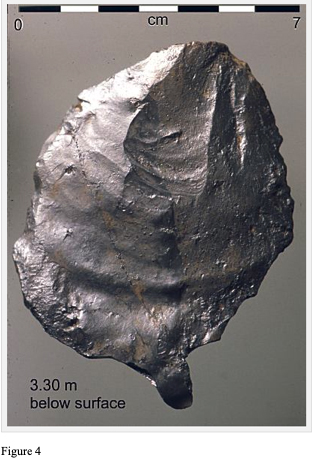
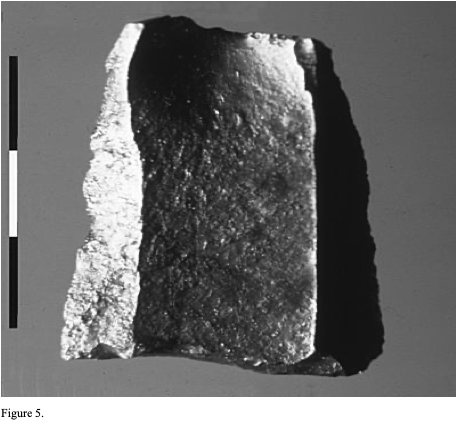
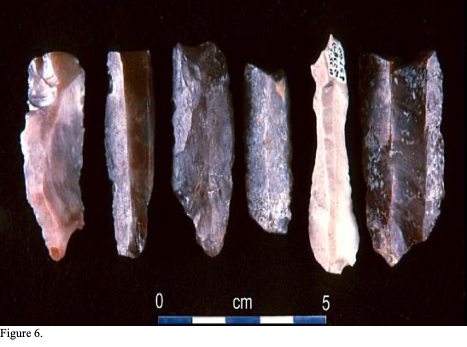
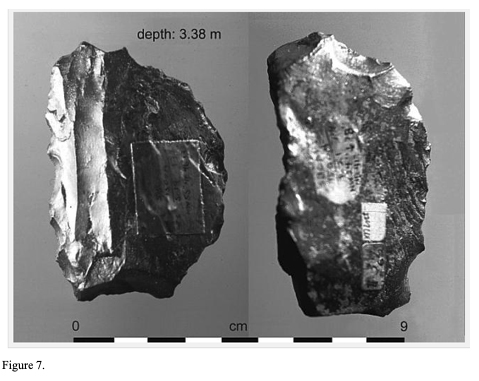
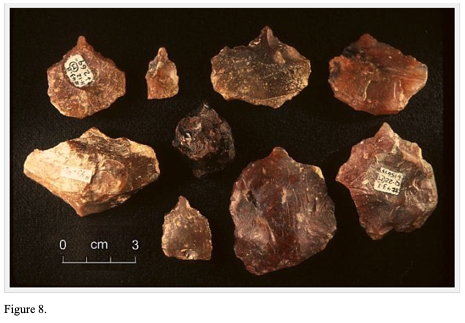
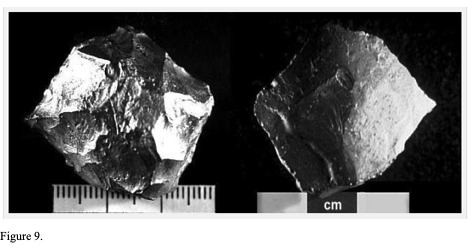
Most choppers exhibit bifacial flaking however, a few are only unifacially worked. Side choppers outnumber end choppers. Lunate-shaped examples with thick, blunt backs and bifacial face and edge flaking are morphologically similar to Asian forms called skreblos.
Handaxe-like tools, typically with massive butt areas, were bifacially flaked from cores or large flakes. One example with a long, broad, thin tongue-like blade exhibits an S-shape outline like Old World forms.
The Calico Cutter (Figure 10) is a multi-functional tool type that has one lateral margin with a well-fashioned sinuous chopper edge at an opposite lateral margin was diagnosed crests retouched for use as cutters.
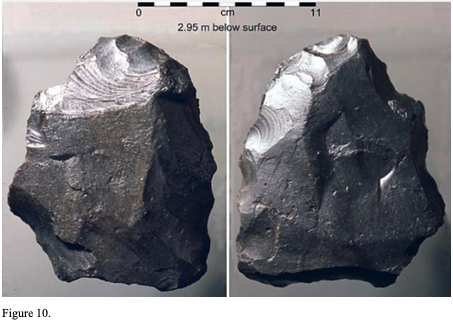
Pointed tools are usually bifacially modified. Most are pics which exhibit retouch and/or use wear indicative of use as multi-functional tools, e.g., as both a pick and a chopper.
In addition to form tools, other lines of evidence indicating man’s presence at the Calico site include:
• Technical flakes with prominent force bulbs (439), diffuse force bulbs (2,793, concentric ripples (2048), bulbs scars (577) and striking platforms (855). Many show evidence of platform preparation such as edge grinding or multiple facets (Singer 1979; Simpson et al. 1986; Simpson et al. 1999).
• Interior flakes with multiple dorsal scars;
• Concavo-convex flakes (second flakes) with force bulbs aligned with negative bulbs of preceding flake removals (296);
• Selective use of high-quality chalcedony including that available within 100 m of the site’s major excavations;
• Clusters of sharp-edged flakes;
• Flake clusters exhibiting size distribution like clusters generated by experimental flaking;
• Evidence of hinge flaking (676);
• Evidence of use-wear, especially crushing, spalling, and rotational wear;
• Concentrations of nonlocal red and yellow ocher;
• Pecked round rock balls (possible bola balls);
• Hammerstones and large hammers (258);
• Non-local quartz crystals, some of which have been modified percussion flaking and others which exhibit use patterns like “bag wear” in much young assemblages; and
• Non-local Eocene moss agate flakes.
The Rock Wren Locality at the Calico Site
A well-formed chalcedony biface was recovered 50 cm below the surface in a drainage channel in the nested unit of alluvium at a location approximately 100 m east northeast of Master Pit I at the Calico Site. Found during a hike when a rock wren bird nest was found on the rocky surface, it has come to be euphemistically called the Rock Wren Biface. Figure 11 is a photograph of both faces of this specimen. The specimen’s face and edge modifications reflect a technique of controlled knapping not evident on either the surface artifacts of the Lake Manix Lithic Industry or the late middle Pleistocene Calico specimens.
Thermoluminescence analysis of sediment stratigraphically equivalent to the base of the biface indicates deposition occurred 14.4±2.2ka (Debenham 1998, 1999). This suggests the Rock Wren biface is an age equivalent to Clovis-era artifacts or slightly earlier. Figure 11 shows the Rock Wren Biface.
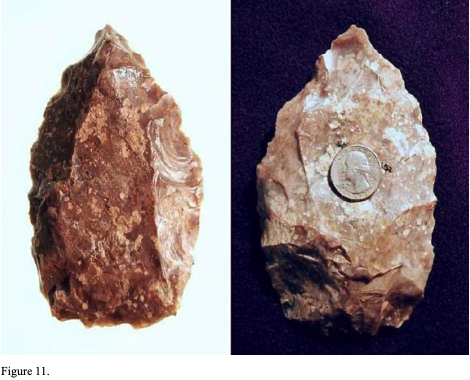
Artifact/Geofact Issues
The artifactual character of the Calico lithic assemblage has been questioned (Haynes 1973; Payen 1982a, 1982b; Taylor and Penn 1979; Duvall and Venner 1979). Haynes (1973) hypothesized that rock fracturing by tectonic stresses, weather, rock-on-rock percussion in streams and mud flows, pressure retouch of buried cobbles, and successive generations of flake removal of separation from cores through cycles of erosion and redeposition could have occurred during the deposition of the alluvial deposits at Calico produce specimens indistinguishable from artifacts.
Such mechanisms do not frequently cause artifact-like fracturing. This is especially true with the small, delicate flaking seen on light-duty tools such as burins, gravers, becs, denticulates, and reamers. Studies indicate that stream transport abrades and rounds rocks quickly; it does not dislodge artifact-like flakes by percussion. Streams can generate only about 10 percent of the force needed to dislodge significant numbers of percussion flakes. Forces in mud flows are lower due to viscosity. If streams produced pseudo-artifacts, dry streambeds would be littered with such specimens. They are not. The only contexts known to produce significant amounts of percussion flaking (and occasional pseudo-artifacts) are high-energy storm conditions on rocky beaches and certain types of rock falls (landslides and waterfalls).
Payen (1982) studied flake scar angles as traits for distinguishing artifacts from geofacts. He tested a method developed by Barnes (1939) who had compared frequency of obtuse angles on eoliths, natural fractures, and artifacts. Barnes found obtuse angles on 72% of eoliths, 75% of natural fractures, and 18% of artifacts and concluded that “The flake tools of an industry… may be considered of human origin if not more than 25% of the angles scar-platform are obtuse (90° and over).” (Barnes 1939:111).
Payen’s study lacks explicit hypotheses specification of the statistical methods used in their testing and statement of assumptions about the nature of statistical distributions involved. It is unclear whether Payen assumed all artifacts in his study to be samples from the same population, or if each separate assemblage was assumed to represent a different population. The same ambiguity applies to different types of geofacts. The possibility of differences in population variances must be addressed before differences between mean values of attribute measurements can be studied whether with analysis of variance or Student’s t-test.
Hypothesis testing can only proceed if an investigator assumes certain things about nature, and through sampling, obtains data from the real world. If the data acquired are sufficiently at odds with the assumption, there is cause to abandon that assumption. If the data are not compellingly different from what is to be expected by assumption, there is no reason for the investigator to abandon his original hypothesis. Failing to reject does not make a very strong case in favor of the original assumption because it amounts to begging the question; rejection, however, is considered a sound basis for disbelieving.
Payen measured all flake angles on each Calico specimen in his sample. It is conceivable that flake scars were confused for striking platforms. Flaking from one side of the specimen can often remove earlier platform areas on the other side. Angles between two flake scares are different from angles between platforms and derivative flake scares.
Payen compared mean angle values for Calico specimens with those of specimen selected as representing controlled and uncontrolled fracture. He found that “Statistically, there is no significant difference between the sample of alleged tools in the uncontrolled fracture series.” (Payen 1982:200). Payen’s conclusion, however, does not follow unambiguously from his data: his controlled and uncontrolled fracture series are not distinct populations. Neither Payen, nor Barnes, has established a single trait criterion for distinguishing artifacts from geofacts.
Duvall and Venner (1979:462) examined the sample of Calico artifacts and concluded that they were formed-selected examples of naturally flake rocks. Their assessment was based on variances in seven attributes (length, width, thickness, flake angle, medial axis angle, lateral edge angle, and distal edge angle) and the comparison with comparable attributes on specimens in eight Paleoindian collections reported by Wilmson (1970). Wilson was concerned with differences in tool technologies and functions, not with distinguishing artifacts from geofacts.
Instead of establishing one null hypothesis, Duvall and Venner list three non-equivalent statements. They fail to demonstrate that any of these statements, or the statistical techniques used in their testing, pertain to the question of artifactuality. In the end, they illustrate only that the examined Calico artifacts are not from the same population as the non-bifacial tools and utilized flakes from certain Paleoindian sites studied by Wilmson.
What then are the necessary and sufficient, objective and testable criteria which can be employed to determine whether a particular lithic collection is artifactual? Leland Patterson has developed a very productive approach (Patterson 1983). This approach focuses on quantifiable definitive morphological and technological attributes such as the presence or absence of force bulbs, bulb scars, ripple lines; the of the striking platform condition (whether intact, crushed, or missing), striking platform type and angle (single, multifaceted, or with remaining cortex). Also examined are the dorsal surface of the striking platform for the presence or absence of small facets and the number of major facets of the dorsal surface. Flake size in terms of square millimeters and flake thickness are also recorded. Finally, the flake is categorized as to type, whether primary (with cortex on the entire dorsal surface), secondary with cortex on part of the dorsal surface), or interior.
Calico Site Geology and geomorphology
The Calico Mountains consist of Mesozoic volcanics intruded and overlain by Tertiary igneous and lacustrine deposits. The Calico Site is located on topographically high-level dissected alluvial deposits known as the Calico Hills. These are separated from the source area by younger alluvial fans, many of which are bounded by apparently active faults. The middle Miocene Barstow Formation contains a wide variety of lacustrine lithologies, including chalcedony and chert. The artifact-bearing Pleistocene mudflows, debris flows, and conglomerates overlying the
Barstow Formation are determined termed the Yermo deposits. An angular unconformity indicates a regional depositional hiatus. The Yermo deposits (about 3 to 10 m thick) are topographically lower than the high-level dissected alluvial fans. Lithologies include weathered tuffs and crystalline igneous clasts in a poorly sorted, silty sand matrix. Lesser amounts of chert and limestone clasts are present. Sequentially younger alluvial deposits nested into older fans off the Calico Mountains are judged to be topographically intermediate, and low, and active fan sediments. Their relative ages can be inferred by comparison with deposits dated using soils and stratigraphic techniques, correlation with Lake Manix shorelines, and regional changes in sedimentation inferentially correlated to the Marine Oxygen Isotope Chronology (Bischoff et al. 1981; Shlemon and Budinger 1990). Accordingly, intermediate-., low-, and active alluvial sediments are thus estimated to be about 60-70ka, 10-20ka, and <10ka respectively.
The Calico Site lies in an area of high neo-tectonism; the Calico and Manix faults are nearby; smaller faults pass near and through the site (Shlemon and Budinger 1990). 1990). Some Quaternary displacements are expressed geomorphically; others have historic seismicity and are clearly active. The Barstow Formation is significantly deformed and the Yermo deposits are locally folded.
Faulting and folding have contributed to greater dissection of surfaces than is typically observed elsewhere in the Mojave Desert. This is especially true compared with Eastern Mojave Desert where high-level fans with well-preserved geomorphic divides and varnished desert pavements may be more than 700ka (Shlemon and Budinger 1990). The deep dissection of the Calico Hills does not necessarily imply that the artifact bearing beds must be at least 500ka, as has been proposed (Haynes 1973). It reflects area-wide, high rates of recent uplift, folding, faulting, and erosion.
Haynes (1973:181) divided the Yermo deposits into the younger and older units and postulated that the base of the 23 m deep Control Pit I was in the upper (younger) Yermo deposits, whereas the sites Master Pits penetrate the artifact-bearing, lower (older) deposits. An alternative hypothesis (Shlemon and Budinger 1990), states that the two, high level fan remnants are stratigraphically reversed. By this view, artifacts from the Master Pits occur in a younger, insert deposit which is been locally displaced by one or more faults.
Evidence for this hypothesis comes from the lithology and grain-size differences between the Master Pits and Control Pit I and from consideration of other climatically controlled fans in this desert. In Control Pit I, reddish-brown arcosic sands, locally interstratified with lenses of pebbles and cobbles predominate; chalcedony and cherts clasts are rare. The Master Pits penetrate topographically middle-level fan deposits from mudflows with mudflows, debris flows, and fanglomerates with many chalcedony and cherts clasts (Shlemon and Budinger 1990). Comparable nested fans elsewhere in the Mojave Desert are thought to represent geomorphic response to regional climatic changes.
Uranium-Series Dating
Uranium series (U-series) dating is also called uranium-thorium dating. It is based on the radioactive decay of a parent element, uranium, down to a daughter element, thorium. This short decay chain is part of a much longer decay chain which ultimately ends with lead, which is stable. This dating method may only be employed on materials, such as calcium carbonate rinds encrusting lithic artifacts (and other clasts in the same strata), which close and remained closed to any exchange of uranium or thorium with the local environment. Fundamental to U-series dating is that uranium is water soluble and thorium is not. In the case of calcium carbonate rinds on Calico specimens, uranium was incorporated at the time of formation and thorium was excluded.
After a particular carbonate rind finished developing, 234U in the carbonate decayed to 230Th. A minimum age for the formation of the carbonate may be determined by assessing the time required for the extant 230Th to have accumulated only through the radioactive decay of the parent, 234U. The carbonate rinds on Calico artifacts are found in a basal mudflow unit and immediately overlying debris flows of the Yermo formation (informal designation). These rinds are interpreted to be of groundwater origin; probably precipitated during, or shortly after, deposition.
At the Calico Site, calcium carbonate in the basal artifact-bearing strata is essentially laminar and parallels crude bedding. These carbonate zones are sometimes perched on underlying, less permeable clay beds. No vertical calcic concentrations are apparent that might indicate post-depositional filling of animal burrows and root tubules. Accordingly, it is hypothesized, that the calcium carbonate at issue was not of pedogenic origin. Rather it is hypothesized that individual episodes of groundwater flow from the adjacent; highly calcareous middle Miocene Barstow Formation Beds imparted individual thin “oyster shell-like” laminations coating of CaC03. The process of crystallization of CaC03 trapped minute amounts of water within the crystal lattice and this water had +6 valance uranium dissolved in it. Typically, in oxidizing environments, such as existed at Calico during Pleistocene times, uranium is fully ionized in a +6 valance state and acts like fully oxidized sulfur; i.e., it is a very soluble and mobile anion. In this state, uranium tends to be precipitated with carbonates and phosphorites. It is his incorporation of uranium at a particular point in time which starts the uranium-thorium clock for that specimen.
Given modern climatological conditions and groundwater levels, it appears that the carbonate-bearing groundwater flows were moving through the sediments during or only shortly after the time of alluviation. Stated another way, the U-series dating, as used in this context, is dating the minimum age of the responsible groundwater event(s) in the alluvial deposit, not the age of the artifacts per se. The artifacts were knapped by early American homonins, discarded to the surface for some amount of time, and subsequently buried and exposed to flows of groundwater.
The first episode of U-series dating by Ku and Bischoff was done on specimens from both Master Pit I and the Ritner’s Ridge test pit using alpha particle counters. Only data derived from Ritner’s Ridge specimens (i.e., specimens 5F and 5H) were reported in the 1981 paper (Bischoff et al. 1981). Specimen 5H had a particularly good carbonate rind and yielded an age of 203+27ka or -20ka. One of the specimens studied from Master Pit I (but not reported) was subsequently restudied 26 years later by Bischoff alone.
Whereas the first dating effort involved the counting of individual emissions of alpha particles (over a two-week period), the second dating effort used the newer and more precise method of ICP-Mass Spectrometry. The second time, only one chopping tool from Master Pit I was studied. This artifact had been studied, but not reported, in the late 1970s and early ’80s. Again, only carbonate rind partially covering unambiguous flake scars were assessed. The specific laminar calcium carbonate rind was 6 mm thick and partially covered flake scars on a chalcedony chopping tool recovered from a depth of 475 cm in Master Pit I. Bischoff analyzed a half-gram fragment of the innermost 4 mm of the rind. He characterized this layer as clear sparry calcite and much purer than the bulk earthy rinds analyzed 26 earlier (see Bischoff et al., 1981).
The new date (derived using the ICP-Mass Spectrometry) is 204.8ka +0.0285/-0.0278ka. This new date agrees well with the earlier series of dates that clustered around 200ka that had required correction for the detrital, non-radiogenic Th. Figure 12 shows the chopping tool dated.

With a temporal separation of 21 years, two independent U-series dating efforts on calcium carbonate rinds over flake scars on artifacts recovered from the basal portion of the Yermo formation have been conducted. Both efforts indicate that the artifact-bearing alluvial deposits at the Calico Early Man Archaeological site exceed 200ka.
SurfaceTerrestrial Cosmogenic Nuclide Dating Using 10Be
Methods have been developed for counting atoms of radionuclides produced by secondary cosmic rays either in the atmosphere or in selected mineral grains present at or near the Earth’s surface. The use of such terrestrial cosmogenic nuclides (TCNs) has facilitated the dating of Quaternary landforms. Given their half-lives, 26Al and 10Be have proven to be particularly useful for studies of Quaternary landforms. Both can be produced from atoms in quartz (silicon dioxide), even cryptocrystalline quartz, such as chalcedony. 26Al is produced by secondary cosmic ray bombardment of silicon atoms, whereas 10Be is produced from oxygen atoms. Cosmic rays can convert a small number of atoms in quartz (SiO2) to other isotopes. Some of the silicon atoms can be converted to aluminum-26 and some of the oxygen atoms can be converted to beryllium-10.
Using surface 10Be dating, the average erosion rate of the remnant fanglomerate at Calico was determined to be 30.5 ±6.2m/Ma. The terrestrial cosmogenic ages of flakes removed from several large deeply implanted surface boulders range from 27ka to 198ka. The oldest of such samples dated to 198 ±21 ka and provides a minimum age of the original alluvial deposition.
The Bassett Point Site
During geoarchaeological investigations of the Manix Formation, a modified chalcedony specimen with the prominent force bulb, radial force lines, step-flaking, any regular space unit facial modification The artifact was found in situ in the uppermost part of Lower Member B of the Manix Formation (Jefferson 1985B) at an elevation of an elevation of 5 m topographically lower than the base the Long Canyon Ash (Budinger 1992, 2000). The social spoon dated at its source on the current plateau of the southern Sierra Nevada by the potassium argon method to 185±50KA (Bacon and Duffield 1981, Izett 1981, Sarna-Wojcicki et al. 1984).
Later work at the Bassett Point yielded twenty-one specimens exhibiting edge and/or face modification of probable cultural origin. Most of the Bassett Point specimen is exhibit unifacial flaking. A few show alternate bifacial edge flaking. Edge modification is localized on fortuitously shaped clasts, especially ones with natural concavities along their edges. Such concavities were sometimes worked by percussion flaking into concave or hollow scraper edges. All twenty-two specimens exhibit fluvial abrasion indicative of transport, possibly from as far as the vicinity of the Calico Site, some 16 km upstream.
References
Alsozatai-Petheo, J.
1975 The East-Rim Site, California (S. B. C. M. 1803): An Early Western Lithic Co-tradition. Unpublished Master’s thesis, Eastern New Mexico State College, Portales, New Mexico.
Bacon, C.R. and L.A. Duffield
1981 Late Cenozoic Rhyolite of the Kern Plateau, Southern Sierra Nevada. American Journal of Science 281:1-34.
Barnes, A.S.
1939 The Differences Between Natural and Human Flaking of Prehistoric Flint Implements. American Anthropologist 41:99-112.
Binning, J.D, R.S. Brown, N. Meek, and E.B. Weil
1985 Intermountain Power Project (IPP): The Cultural Resources Study of the Ground Electrode Facility at Coyote Lake, San Bernardino County, California. Prepared for the City of Los Angeles, Department of Water and Power by Applied Conservation Technology, Inc., Westminster, California.
Bischoff, J.L., R.J. Shlemon, T.L. Ku, R.D. Simpson, R.J. Rosenbauer, and F.E. Budinger, Jr.
1981 Uranium-series and Soils-geomorphic Dating of the Calico Archaeological Site, Geology 9(12):576-582.
Budinger, F.E., Jr.
1983 Evidence for Pleistocene Man in America: The Calico Early Man Site, San Bernardino County, California. California Geology 36(4): 75-82.
Budinger, F.E., Jr.
1992 Targeting Early Man Sites in the Western United States: An Assessment of the Manix Type Section, Central Mojave Desert, California. Unpublished Master’s thesis, California State University, San Bernardino.
Budinger, F.E., Jr.
2000 Modified Lithic Specimens from the Lower Member B of the Manix Type Section, Central Mojave Desert, California. Society for California Archaeology Proceedings. Society for California Archaeology, Fresno, California.
Budinger, F.E., Jr. and R.D. Simpson
1985 Evidence for Middle and Late Pleistocene Man in the Central Mojave Desert of Southern California. In Woman, Poet, Scientist: Essays in the New World Anthropology Honoring Dr. Emma Louise Davis, compiled and edited by the Great Basin Foundation, pp. 16- 36. Ballena Press, Los Altos, California.
Budinger, F.E., Jr., T.M. Oberlander, and J.A. Bischoff
2024 The Calico Site: Site Age and the Artifact/Geofact Issue. Article in preparation for publication in California and Great Basin Anthropology.
Debenham, N
1998 Thermoluminescence Dating of Sediment from the Calico Site (California) (CAL1). Quaternary TL surveys, Nottingham, United Kingdom.
Debenham, N.
1999 Thermoluminescence Dating of Sediment from the Calico Site (California) (CAL2). Quaternary TL surveys, Nottingham, United Kingdom.
Duvall, J.G. and W.T. Venner
1979 A Statistical Analysis of the Lithics from the Calico Site (SBCM 1500A), California. Journal of Field Archaeology 6(4):455-462.
Haynes, C.V.
1973 The Calico Site: Artifacts or Geofacts? Science 181:305-310.
Izett, G.A.
1981 Volcanic Ash Beds: Recorders of Upper Cenozoic Silicic Pyroclastic Volcanism in the Western United States. Journal of Geophysical Research 86 (B 11): 10,200-10,222.
Jefferson, G.T.
1968 The Camp Cady Local Fauna from Pleistocene Lake Manix, Mojave Desert, California. Unpublished Master’s thesis, University of California, Riverside.
Jefferson, G.T.
1985a Review of the Late Pleistocene Avifauna from Lake Manix, Central Mojave Deset, California. History Museum of Los Angeles, Contributions in Science 362:1-13.
Jefferson, G.T.
1985 Stratigraphy and Geologic History of the Pleistocene Manix Formation, Central Mojave Deset, California. In Cajon Pass to Manix Lake; Geologic Investigations Along Interstate 15, compiled by R.E. Reynolds, pp. 157-169. San Bernardino County Museum, Redlands, California.
Jefferson, G.T.
1989 Late Pleistocene and Earliest Holocene Fossil Localities and Vertebrate Taxa from the Western Mojave Desert. In The West-central Mojave Desert: Quaternary Studies between Kramer and Afton Canyon, edited by R.E. Reynolds, pp. 27-40, Special Publication, San Bernardino County Museum Association, Redlands, California.
Jefferson, G.T.
1991 A Catalog of Late Quaternary Vertebrates from California: Part One, Nonmarine Lower Vertebrate and Avian Taxa. Natural History Museum of Los Angeles County, Technical Reports, No. 5.
Meek, N.
1989 Physiographic History of the Afton basin, Revisited. In The West-central Mojave: Quaternary Studies Between Kramer and Afton Canyon, edited by R. E. Reynolds, PP. 78-83. San Bernardino County Museum Association, Redlands, California.
Meek, N.
1990 Late Quaternary Geochronology and Geomorphology of the Manix Basin, San Bernardino County, California. Unpublished PhD dissertation, University of California, Los Angeles.
Meek, N.
1999 New Discoveries about the Late Wisconsinan History of the Mojave River System. In Tracks Along the Mojave: A Field Guide from Cajon Pass to the Calico Mountains and Coyote Lake, edited by R. E. Reynolds and J. Reynolds, San Bernardino County Museum Association, Redlands California.
Owen, L.A., T. Davis, M.W. Caffee, F. Budinger, and D. Nash
2011 Surface Ages and Rates of Erosion at the Calico Archaeological Site in the Mojave Desert. Geomorphology 125:4050.
Patterson, L.W.
1983 Criteria for Determining Attributes of Man-Made Lithics. Journal of Field Archaeology 10:297-307.
Payen, L.A.
1982a Artifacts or Geofacts at Calico. Application of the Barnes Test. In Peopling of the New World, edited by J.E. Ericson, R. Berger, and R.E. Taylor, pp. 193-201. Ballina Press, Los Altos, California.
Payen, L.A.
1982b The pre-Clovis of North America: Temporal and Artifactual Evidence. Unpublished PhD dissertation, University of California, Riverside.
Reheis, M.C., D.M. Miller, J.B. Paces, C.G. Oviatt, J.R. Redwine, D. Kaufman, J. Bright, and E. Wan
2011 Geomorphic History of Lake Manix, Mojave Desert, California: Evolution of a Complex Terminal Lake Basin. Geomorphology 392, November 2021, 107901.
Sarna-Wojcicki, A.M., R.H. Bowman, C.E. Meyer, P.C. Russell, M.J. Woodward, G. McCoy, J.J. Rowe, Jr. P.A. Baedecker, F. Asaro, and M. Michael
1984 Chemical Analyses, Correlations, and Ages of Upper Pliocene and Pleistocene Ash Layers of East Central and Southern California. U.S. Geological Survey Professional Paper 1293.
Schuiling, W. (editor)
1972 Pleistocene Man at Calico. San Bernardino County Museum Association, Bloomington, California.
Schuiling, W. (editor)
1979 Pleistocene Man at Calico. San Bernardino County Museum Association, Redlands, California.
Shlemon, R.J. and F.E. Budinger, Jr.
1990 The Archaeological Geology of the Calico Site, Mojave Desert, California. In Archaeological Geology of North America, edited by N. P. Lasker and J. Donahue, pp. 301-313. Centennial Special Volume 4, Decade of North America Geology series, Geological Society of America, Boulder, Colorado.
Simpson, R. D.
1960 Archaeological Survey of the Eastern Calico Mountains. The Masterkey 34 (1): 25-35.
Simpson, R. D.
1976 The Manix Lake Industry: Early Lithic Tradition or Workshop Refuse? A Commentary on W. Glennon’s Article. Journal of New World Archaeology 1(1):63-66.
Simpson, R. D.
1978 The Calico Mountains Archaeological Site. In Early Man in America from a Circum-Pacific Prospective, edited by A. L. Brian, PP. 218-220. Department of Anthropology, University of Alberta, Occasional Papers, No. 1.
Simpson, R. D.
1980 The Calico Mountains Site: Pleistocene Archaeology and the Mojave Desert. In Early Native Americans: Prehistoric Demography, Economy, and Technology, edited by D. I. Broman, pp. 7-20. Mouton, The Hague.
Simpson, R. D.
1982 The Calico Mountains Archaeological Project: A Progress Report. In Peopling of the New World, edited by J. Erickson, R. Berger, and R.E. Taylor, pp.181-192. Ballena Press, Palo Alto, California.
Simpson, R. D.
1999 An Introduction to the Calico Early Man Lithic Assemblage. San Bernardino County Museum Association Quarterly 46(4).
Simpson, R. D., L.W. Patterson, and C.A. Singer
1986 Lithic Technology of the Calico Mountains Site, Southern California. In Evidence of the Pleistocene Peopling of the Americas, edited by A.L. Brian, pp. 89-105. Center for the Study of Early Man, University of Maine, Orono.
Singer, C.A.
1979 A Preliminary Report on the Analysis of Calico Lithics. In Pleistocene Man at Calico, edited by W. C. Schuiling, pp. 55-66. San Bernardino County Museum Association Quarterly 26 (4).
Taylor, R. E. And L. A. Payen
1979 The Role of Archaeometry in American Archaeology: Approaches to the Evaluation of the Antiquity of Homo sapiens in California. In Advances in Archaeological Method and Theory, vol. 2, edited by M. B. Schiffer, pp. 239-283. Academic Press, New York.
Figure Captions
Figure 1. Map of the Manix Basin (Lower Mojave River Valley) in the Central Mojave Desert of Southern California. Map shows the most recent stand of Pleistocene Lake Manix and the Calico Early Man Archaeological Site. Credit: © D.M. Burke.
Figure 2. Lake Manix Lithic Industry artifacts cover the Calico Hills down to an elevation of 453 m. That elevation contour was the shoreline of the last stand of Pleistocene Lake Manix. The lake drained approximately 25ka and the artifacts are at least that old. Credit: © Daniel J. Griffin photo.
Figure 3. Lithic tools, flakes, blades, and blade cores of the Calico Lithic Industry. These specimens have been coated with powdered aluminum to accentuate surface morphologies. Credit: © Daniel J. Griffin.
Figure 4. Large soft hammer flake with platform lipping, bulb scar, and distinct ripples. This specimen has been coated with powdered aluminum to accentuate surface morphology. © Daniel J Griffin.
Figure 5. A concavo-convex flake. This is an unusual type of flake; it was produced by two identical strikes on the same striking platform. 296 such concavo-convex have been found. This specimen has been coated with powdered aluminum to accentuate surface morphology. Credit: © Daniel J. Griffin photo.
Figure 6. Chalcedony blades from various depths from 1.45 m to 4.5 m in Master Pit I at the Calico Site. Credit: © Daniel J. Griffin.
Figure 7. Two scrapers from the Calico Site. The specimens have been coated with aluminum powder to accentuate surface morphology. Credit: © Daniel J. Griffin.
Figure 8. Nine reamers (rotational tools) from the Calico Site. Credit: © Daniel J. Griffin.
Figure 9. A graver recovered from a depth of 3.99 m in Unit P-20 in Master Pit I at the Calico Site. This specimen has been coated with powdered aluminum to accentuate surface morphology. © Daniel J. Griffin.
Figure 10. This Calico Cutter, a combination chopping and cutting tool recovered from a depth of 2.95 m. Three large oblique crests were produced as cutting edges. Alternate bifacial flaking was done to produce a chopping edge. This specimen has been coated with powdered aluminum to accentuate surface morphology. Credit: © Daniel J. Griffin.
Figure 11. The Rock Wren Biface was found in a nested inset of alluvium dated to 14.4±2.2ka. It shows evidence of heat treatment. Credit: © Daniel J. Griffin.
Figure 12. A chopping tool recovered from Master Pit I at a depth of 4.75 m. A sample of the calcium carbonate rind covering distinct flake scars was dated to 205+2.9/-2.8ka by uranium-series dating. © Fred E. Budinger, Jr.

